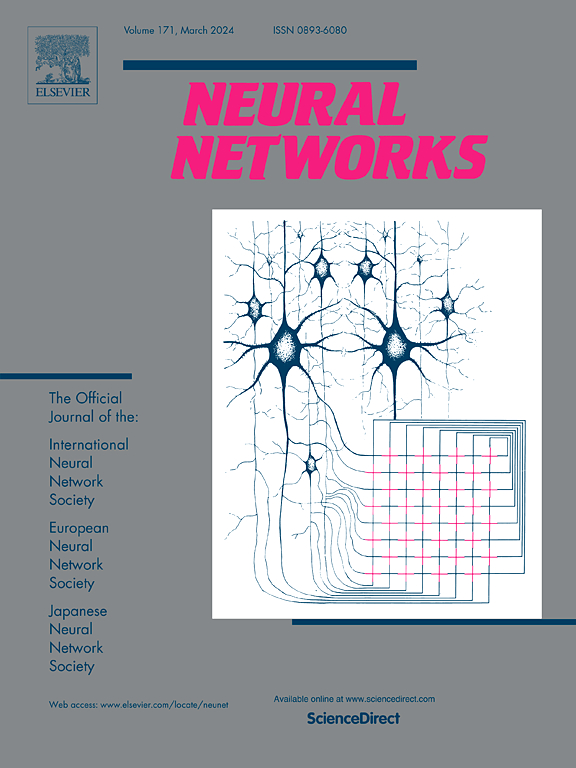用于图形级表征学习的图形显式池。
IF 6
1区 计算机科学
Q1 COMPUTER SCIENCE, ARTIFICIAL INTELLIGENCE
引用次数: 0
摘要
人们越来越认识到,图集合对于图神经网络(GNN)促进分层图表示学习至关重要。现有的图集合方法通常包括两个阶段:选择排名靠前的节点和丢弃剩余节点,以构建粗化图表示。然而,本文强调了这些方法的两个关键问题:(1) 在选择要丢弃的节点的过程中,经常使用额外的图卷积网络或多层感知器,缺乏对每个节点对最终图表示和后续预测任务的影响的全面评估。(2) 当前的图集合方法倾向于直接丢弃图中的噪声段(丢弃),而不考虑这些元素中包含的潜在信息。为了解决第一个问题,我们引入了一种新颖的图形显式池化(GrePool)方法,该方法通过显式利用节点与对分类至关重要的最终表示向量之间的关系来选择节点。第二个问题是使用 GrePool 的扩展版本(即 GrePool+)来解决的,该版本对丢弃的节点采用统一损失。这一新增功能旨在增强训练过程并提高分类准确性。此外,我们还在 12 个广泛使用的数据集上进行了综合实验,以验证我们提出的方法的有效性,其中包括开放图基准数据集。实验结果一致表明,GrePool 在大多数数据集上都优于 14 种基准方法。同样,GrePool+ 的实施在不增加计算成本的情况下提高了 GrePool 的性能。代码见 https://github.com/LiuChuang0059/GrePool。本文章由计算机程序翻译,如有差异,请以英文原文为准。
Graph explicit pooling for graph-level representation learning
Graph pooling has been increasingly recognized as crucial for Graph Neural Networks (GNNs) to facilitate hierarchical graph representation learning. Existing graph pooling methods commonly consist of two stages: selecting top-ranked nodes and discarding the remaining to construct coarsened graph representations. However, this paper highlights two key issues with these methods: (1) The process of selecting nodes to discard frequently employs additional Graph Convolutional Networks or Multilayer Perceptrons, lacking a thorough evaluation of each node’s impact on the final graph representation and subsequent prediction tasks. (2) Current graph pooling methods tend to directly discard the noise segment (dropped) of the graph without accounting for the latent information contained within these elements. To address the first issue, we introduce a novel Graph explicit Pooling (GrePool) method, which selects nodes by explicitly leveraging the relationships between the nodes and final representation vectors crucial for classification. The second issue is addressed using an extended version of GrePool (i.e., GrePool+), which applies a uniform loss on the discarded nodes. This addition is designed to augment the training process and improve classification accuracy. Furthermore, we conduct comprehensive experiments across 12 widely used datasets to validate our proposed method’s effectiveness, including the Open Graph Benchmark datasets. Our experimental results uniformly demonstrate that GrePool outperforms 14 baseline methods for most datasets. Likewise, implementing GrePool+ enhances GrePool’s performance without incurring additional computational costs. The code is available at https://github.com/LiuChuang0059/GrePool.
求助全文
通过发布文献求助,成功后即可免费获取论文全文。
去求助
来源期刊

Neural Networks
工程技术-计算机:人工智能
CiteScore
13.90
自引率
7.70%
发文量
425
审稿时长
67 days
期刊介绍:
Neural Networks is a platform that aims to foster an international community of scholars and practitioners interested in neural networks, deep learning, and other approaches to artificial intelligence and machine learning. Our journal invites submissions covering various aspects of neural networks research, from computational neuroscience and cognitive modeling to mathematical analyses and engineering applications. By providing a forum for interdisciplinary discussions between biology and technology, we aim to encourage the development of biologically-inspired artificial intelligence.
 求助内容:
求助内容: 应助结果提醒方式:
应助结果提醒方式:


